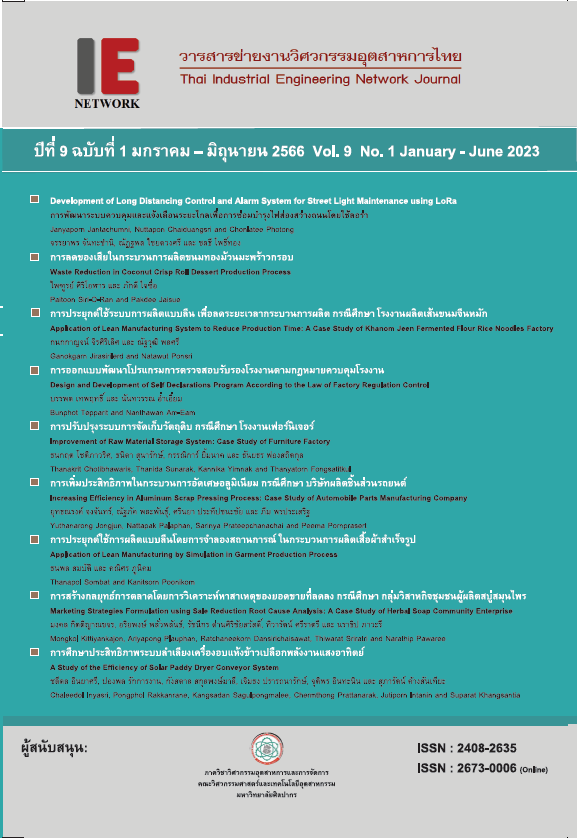A Study of the Efficiency of Solar Paddy Dryer Conveyor System
Main Article Content
Abstract
The objective of this research is to study of the efficiency of solar paddy dryer conveyor system. It has designed a solar dryer structure made of steel, walls and roof with polycarbonate sheets. It has a continuous vortex moving conveying system into the paddy drying room using a 3-meter shaftless screw conveyor. There is an electric brushless DC motor with 750 watts 48 volts, which is powered by lithium batteries with 53 volts 30 amp-hours (Ah). The experiment of the drying system was conducted during 6:00-18:00 hr. The results showed that the average temperature inside the drying chamber was 41.44 °C. The thermal efficiency compared to the day's average solar radiation efficiency was 18.88%. In addition, 50 kg of paddy was dried by solar energy with an initial moisture content of 19% to a final moisture content of 14%. The speed adjustment of the shaftless screw conveyor paddy rice conveying system was tested at 3 levels: 65, 144 and 155 rpm which found that the percentage of broken paddy was 13.63%, 19.04% and 22.22% respectively. The results of this study suggest that the speed of conveying paddy into the drying room at 65 rpm had the least effect on the percentage of paddy fragmentation, with the increase of the speed of the paddy on the increase of the percentage of fragmentation of paddy.
Article Details

This work is licensed under a Creative Commons Attribution-NonCommercial-NoDerivatives 4.0 International License.
บทความ ข้อมูล เนื้อหา รูปภาพ ฯลฯ ที่ได้รับการตีพิมพ์ในวารสารฯ ถือเป็นลิขสิทธิ์ของวารสารฯ หากบุคคลหรือหน่วยงานใดต้องการนำทั้งหมดหรือส่วนหนึ่งส่วนใดไปเผยแพร่ต่อหรือเพื่อกระทำการใดๆ จะได้รับอนุญาต แต่ห้ามนำไปใช้เพื่่อประโยชน์ทางธุรกิจ และห้ามดัดแปลง
References
กองวิจัยและพัฒนาข้าว. วิทยาการก่อนและหลังการเก็บเกี่ยว (การลดความชื้น) [อินเทอร์เน็ต]. [เข้าถึงเมื่อ 10 มีนาคม 2565]. เข้าถึงได้จาก: https://www.ricethailand.go.th/rkb3/PostharvePo.htm.
พริสิทธิ์ทวยนาค มณฑล ชูโชนาค มุสตาฟา ยะภา ประชา บุณยวานิชกุล. การทบทวนพัฒนาการของการลดความชื้นข้าวเปลือกในทางอุตสาหกรรม. วารสารวิศวกรรมศาสตร์มหาวิทยาลัยศรีนครินทรวิโรฒ. ปีที่ 9; ฉบับที่ 1 เดือนมกราคม – มิถุนายน 2557: 68-74.
กรมวิชาการเกษตร. คุณภาพและการตรวจสอบข้าวหอมมะลิไทย. กระทรวงเกษตรและสหกรณ์ สำนักงานเศรษฐกิจอุตสาหกรรม. 2547: 9.
พันคำ ศรีอุทัย, พรชัย จงจิตรไพศาล, ณรงค์โมกขวิสุทธิ์, ยรรยง ศรีสม, ศุภชัย ตระกูลทรัพย์ทวี. ขนถ่ายวัสดุ ชุดที่ 2. กรุงเทพฯ: เอ็มแอนด์อีบจ; 2552. 308.
พรชัย จงจิตรไพศาล. สกรูขนถ่ายวัสดุ. สมาคมส่งเสริมเทคโนโลยี ไทย-ญี่ปุ่น. กรุงเทพฯ. 2548. 236.
มาโนช วิทันโย, สุทัศน์ ยอดเพชร, การัณย์ หอมชาติ. การพัฒนาเครื่องลำเลียงเมล็ดข้าวเปลือก. วารสารวิจัย มหาวิทยาลัยเทคโนโลยีราชมงคลธัญบุรี 2549; 10(1): 73-80.
สมชาย โพธิ์พะยอม, พินิจ บุญเอี่ยม, นิติกร หลีชัย, วริศ จิตต์ธรรม, ประเทียบ พรมสีนอง และศักดิ์สิทธิ์ ชื่นชมนาคจาด. การออกแบบและพัฒนาเครื่องสกรูลำเลียงดินในกระบวนการผลิตอิฐบล็อกประสาน. วารสารวิจัยเทคโนโลยีนวัตกรรม. 2563. ปีที่ 4; ฉบับที่ 1: 16-20.
ชัยวัฒน์ พรหมเพชร. เครื่องอบผลปาล์มแบบสกรูวิทยานิพนธ์ วิศวกรรมศาสตรมหาบัณฑิต สาขาวิศวกรรมเครื่องกล บัณฑิตวิทยาลัยมหาวิทยาลัยสงขลานครินทร์; 2556. 182.
ปองพล รักการงาน, กังสดาล สกุลพงษ์มาลี และชลีดล อินยาศรี. การใช้ความร้อนจากระบบผลิตน้ำร้อนพลังงานแสงอาทิตย์ร่วมกับระบบอบแห้งพลังงานแสงอาทิตย์. วารสารวิชาการพลังงานทดแทนสู่ชุมชน. ปีที่ 5; ฉบับที่ 1 เดือนมกราคม-เมษายน 2565: 16-24.
อภิชาต อาจนาเสียว และสมควร แววดี. การลดการแตกหักในโรงสีข้าว (ส่วนที่ 1 การอบแห้ง ทำความสะอาดและกะเทาะ). การประชุมวิชาการข่ายงานวิศวกรรมอุตสาหการ ประจำปี พ.ศ.2555: 2334-2339.


